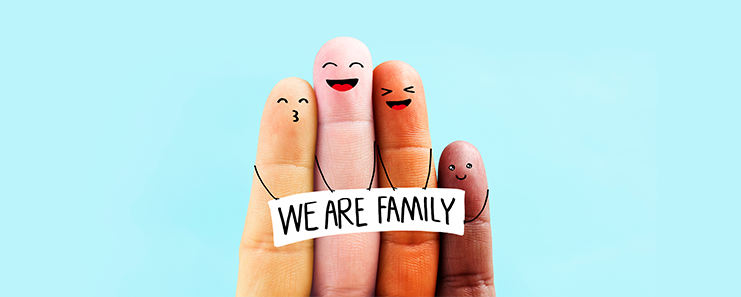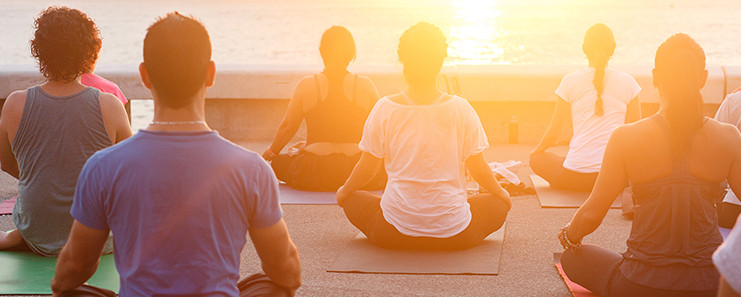My mother is from Haryana, and my father is from Delhi. One set of my grandparents lived most of their lives in modern day Pakistan, while the other are, for all practical purposes, Bengalis. I am married to a Tamilian. One of my children is married to a Maharashtrian, while the other is married to a Canadian, of Punjabi origin. Oh, did I mention that my sister married a Nairobian?! Can you blame me if the question I dread the most is, “Where are you from?!”
This is my friend Geetika (Geethika, according to her South Indian husband). She is among a growing class of ‘global citizens’. The ones who don’t belong to any one place because they (or their ancestors) moved away from their home states for studies, marriage or work.

Many people have multiple roots, but today, the roots have disregarded state and national boundaries and spread themselves generously without bar - courtesy globalization, immigration, wars, and the resultant refugee crisis. These have all led to inter-mingling of various cultures in a smaller geographical area. Contrary to popular perception, this mixing of cultures is not a new phenomenon. From time immemorial, humans have moved to better pastures, and settlements that are more favorable.
Living in diverse culture has led to more exposure to the world for our children in their own neighbourhood. It is a great opportunity for growth – in theory. The truth is that it has also led to the conflict we see and hear all around us. You will find several stories of harassment and racism faced by people who are perceived to be threats in an increasingly multicultural society.
The United Nations’ official site, has published several real life stories of people who have faced discrimination based on their cultural differences: religion, nationality, minority status, physical appearance, medical condition, orientation, or gender identity. The discrimination has led to these people living in abject poverty, with no access to medical facilities, schools, or jobs, and in general isolation from the public.
It’s all very well to say, “We should be tolerant and accepting, broaden our mental horizons, and be more inclusive.” But, how do you do it? We all feel threatened when we encounter people, who do not fit our idea of ‘normal’. The insecurity leads to discomfort, fear and suspicion. In extreme cases, it leads to hate crimes and genocides, as we have seen in the past and present.
Any solution cannot be symptomatic; it must address the core issue that is our lack of awareness, which has led to the insecurity in the first place. Strife begins because people feel uncomfortable with the unfamiliar, and cannot accept differences.
Here are some ideas on how to overcome this shortcoming in a world that is increasingly become multicultural.
How to live in a multicultural society
1) Learn a new tongue
Language can help break barriers. It is, specifically, important to learn the language of the region you live in. You might also consider learning languages of regions near your country, or in a place like India, of neighboring states; it can help integrate you with the people you live or work with. This can be done without downplaying the importance of your language.

Protecting language is vital. There are various truths hidden in the texts of ancient languages that can be of use to us today. For instance, Sanskrit is a language that is not spoken much today but it can help you understand an edifying text like the Bhagavad Gita; it is also the base of several languages.
2) Make space for differences to co-exist in harmony without homogeneity
Diversity needs to be honored, acknowledged and celebrated. It is the basis of existence. In the Vedas, the Divine says, ‘I am one, but I become many.’ Why? In ‘many’ there is bliss. To express the bliss that I am, I became many. So, diversity should be celebrated.
-Gurudev Sri Sri Ravi Shankar
There is so much to learn from the diversity around us. Instead of searching for common threads that link practices, we would be better off appreciating the exotic and unique nature of these different practices. When we try to customize tradition to suit the majority, we kill the essence of the learning hidden in them. In those very differences, lie the base for new ideas and innovations.

The threat that makes us all less accepting of the differences around is that our identity is getting lost amidst the homogenization of cultures. This, particularly, happens in urban areas, where large groups of people migrate from smaller regions.
Dubai is a great example of how different cultures co-exist together. You will find people from India, Pakistan, Bangladesh, Philippines, and Britain living here along with the Emiratis. Because of and despite the variety of people living here, it is one of the most peaceful and thriving economies in the world.
3) Support ethnic wear day at work or school
Many workplaces do this annually. And schools do this at kindergarten levels. It can be extended and expanded to really help appreciate the various cultures that tend to get squashed in the modern way of living.
Workplaces can introduce this kind of special day once a quarter, to invite employees to dress up in their regional ethnic wear. To really celebrate diversity, we should ensure that as many regions/states are represented as possible to, wholesomely, display the rich diversity of any region.

Culture goes a long way in binding people. When you evoke creativity and interest through social practices, there is better understanding and acceptance of the different cultures around us. What you recognize as common and normal becomes more easily acceptable.
The fact that a lot of older practices of our rich legacy are dying, has caused people to become fanatical and divisive about their language, caste, class, culture, and religious practices. Instead, a policy of ‘Promote and protect peacefully’ can be followed.
4) Promote frequent job transfers
If you analyze the success of any region today, you will find that the best people from different backgrounds came together to make it happen. This is true of most of the big cities of the world – New York, London, Mumbai, or Dubai. Diversity and an open-minded attitude have made them the progressive societies they are today.
Job transfers can help promote this. When people move to different places, (especially places they would not have gone to on their own), they gain perspective about different cultures. It will help get rid of xenophobia. Pushed out of your traditional comfort zone into a new space, amidst different people, you have more scope for novelty and innovation.
 Simple practices to follow to adapt to a diverse society
Simple practices to follow to adapt to a diverse society
- Avoid generalizing people according to groups. Just as our life cannot be summarized based on our gender, nationality or say, line of employment, we should not subject people to our stereotypical notions and personal prejudices.
- Take care of your language and manners. Every culture has its own traditions and ways. Never mock people or make their stories a parody for a couple of laughs.
- Get to know the cultural background of the people in your city, and develop sensibilities that respect their practices and habits. When you start to become familiar with it, you will find it endearing rather than unnerving.
- Develop a healthy curiosity to learn about the differences in other people’s traditions that you don’t understand. Strength comes from knowing the people you live with. When you learn about other cultures, you start to see beyond color of skin, physiognomy, intonations and accents.
- Give up the notion of ‘normal’ and ‘abnormal’. Just be - with yourself and with others.
- Promote multiculturalism on boards of organizations and union of schools to ensure that everyone’s voice is heard.
5) Organize film festivals in schools and colleges
About seven years ago, a friend raved to me about the content and production value of Korean dramas. As an Indian non-watcher of local dramas, naturally, I was not even slightly intrigued. However, I tried a scene of a drama. I was quite surprised to see how familiar the characters felt. They were speaking in a foreign language with practices as different as possible from my own and yet, I found myself laughing and crying with them. That sense of integration was a powerful feeling.
What the visual media does is that it shows you a piece of another culture in a light you had not known or imagined. It plants ideas in your head that are either new, or ones that break your parochial notions. Film festivals celebrating the best from different regions can be screened for school and university students to know and absorb the variety around them. At that moldable age, children are in the best position to embrace the diversity around them.
6) Meditate to integrate
Wherever I go, I feel at home.
- Gurudev Sri Sri Ravi Shankar
What a secure and comfortable feeling that is!
Perhaps the strongest means of integrating diverse groups of people is by going within. Where we are all essentially the same. All you have to do is close your eyes, and sit in silence. If you are a beginner, Gurudev’s guided meditation can take you on your journey towards balance and centeredness. When you connect with the spirit within, the boundaries outside disappear and you connect with people seamlessly.
So, when you open your eyes, you see beyond diversity into the unity and oneness that is before you.
Imagine the possibilities of integration, amidst diversity, if this is encouraged for people in walks of life – students, homemakers, senior citizens, and the entire workforce!
This article was written by Anusha Chellappa with inputs from Dr. Prema Seshadri, Faculty, Art of Living


































